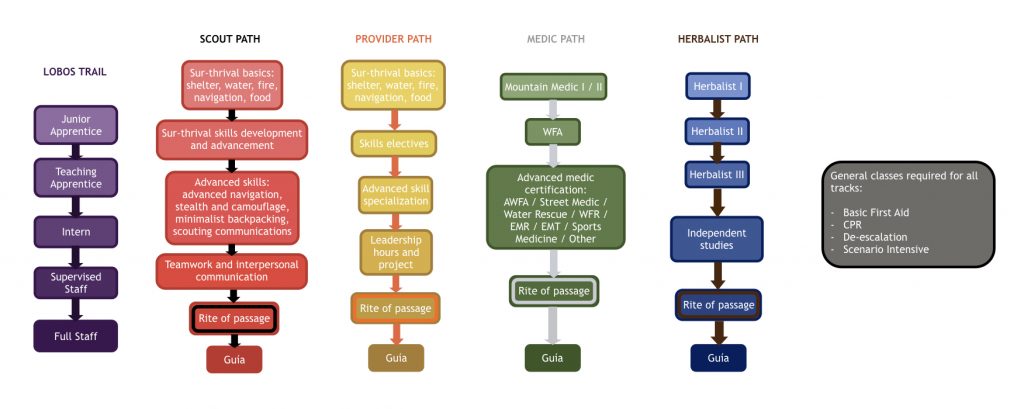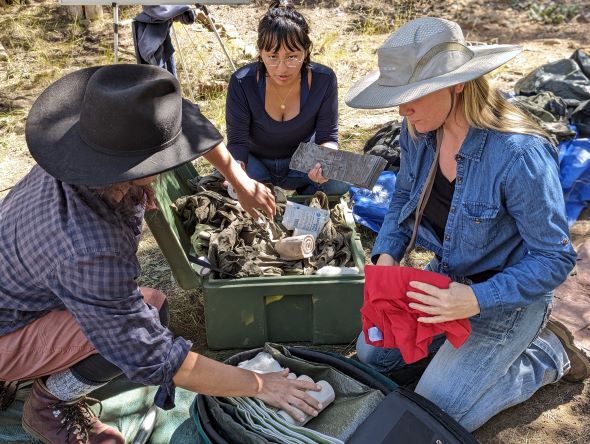Mountain SOL has been growing, which we are all very excited about! In an effort to create the best experience for our older students, our new students, our new teachers, and our diverse classes, we have organized our school into four official paths through the Mountain SOL curriculum. This way, we can standardize our Mountain SOL knowledge, allow students to specialize in the areas in which they are interested, and provide a defined route to developing their practical skills, advancing their leadership and teamwork abilities, and becoming a role model community member.
A huge thank you to The Human Path; this structure of paths came directly from how they have organized their school. With their blessing, we adapted the system and created our own paths. The Human Path is a school based in New Mexico that teaches wilderness survival skills, first aid, herbalism, off-grid engineering, self-defense, and much more to adults both in their area and online. So, parents of our Mountain SOL kids, if you’re interested in the same skills we teach your kids, go check out The Human Path.
Our four paths are Scout, Provider, Medic, and Herbalist. Students can complete more than one path, but they are encouraged to focus on one at a time. Once a student completes a path, they become a guide, or guía, for that path, and they help mentor other students through that path.

The Scout path is currently primarily completed at Cheat Mountain. Scouts learn basic sur-thrival skills such as fire building, building shelter, foraging wild edible plants, and finding clean water, as well as skills designed to prepare our scouts to be comfortable and confident as an advance team for a larger group. These skills include camouflage, efficiently packing a backpack, and advanced navigation. As students progress through the path, the focus shifts to learning how to work as an effective scout pack and developing interpersonal and leadership skills. As the final step, students choose three projects that they believe will sufficiently challenge their practical and mental abilities before graduating the path.
The Provider path focuses on the functioning of the larger group. Providers learn basic sur-thrival skills such as navigation, how to build shelters, make fires, forage for wild edibles, and find potable water, but they also learn skills that help them provide for their group such as fishing, the making of multi-person shelters, cooking over an open fire, and proper storage of firewood. Beyond this, providers spend time developing leadership and group communication skills, including being the official Provider on a campout, trip, or class, and complete individually selected projects to develop leadership and communication skills. Providers also choose a skill specialty which they develop and then choose a final project to demonstrate their abilities.
The Medic path trains students to be prepared for first aid emergencies. Medics begin with basic first-aid training and CPR, and then they progress to complete their Wilderness First Aid certification, which includes formal medical notes and preliminary injury treatment. After that, students choose and complete a more advanced certification such as Advanced Wilderness First-Aid training, EMR and EMT training, Street Medic training, or water rescue training. Finally, students are an official medic during a trip or class, which includes caring for any minor injuries and responding to any situation that may arise. Throughout the Medic path, students are given challenging scenarios that test their instincts and knowledge retention and develop their ability to stay calm and focused while under pressure, preparing them for real medical emergencies they may face.
The Herbalist path teaches students how to work with herbal medicine in the human body as well as the basics of herbal medicine-making. In this path, students learn how the body functions and how herbs act within our bodies. Students create their own materia medica, a personal record of their knowledge of each of the many herbs about which they learn, and they also learn how to grow, harvest, prepare, and safely use these herbs. After students have completed their classwork, they partake in an herbal clinic run by the WV Herbal Medics chapter, or they develop, with their mentors, their own herbalism final project to complete the path.
Additionally, there is a Lobos trail. Trails are not part of our main paths, but they are other avenues for students to pursue. The Lobos trail is our teacher training program, where we guide our older students and new teachers to become fully-trained Mountain SOL teachers. This includes time spent shadowing teachers, serving as a teacher’s apprentice, and interning, all of which is laid out as organized and defined expectations of progression. In addition to learning the teaching values and methods of Mountain SOL, all Lobos are required to be certified in Wilderness First Aid.
We are able to offer first aid certification for our Mountain Medic program through the support of our friends at the Herbal Medics Academy / Human Path. Our Jags paths were also largely influenced by our mentorship from Sam and Suchil.
Are you interested in taking your wilderness medic skills to the next level? Learn more about the Austere Medicine Program.


